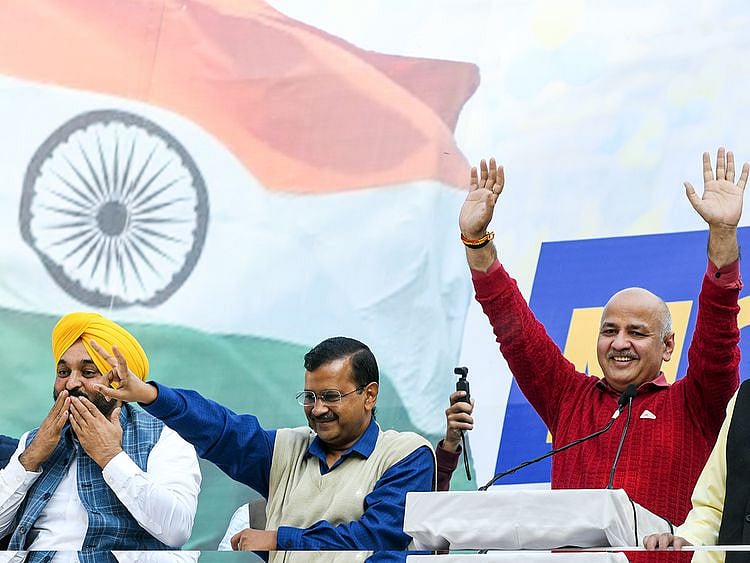In Indian politics, 2022 was the year of Arvind Kejriwal
From Punjab to Gujarat, Kejriwal has shown he’s more than just the Delhi chief minister

Kanshi Ram, founder of the disruptive Bahujan Samaj Party, famously came up with the three election cycle theory of power.
We fight the first election to lose, he said, the second one to defeat and the third one to win.
The Aam Aadmi Party (AAP) contested the 2017 Gujarat assembly elections only in name, and won less than 1% votes. They have now reached the second stage: they have helped the BJP hand the Congress party its worst defeat ever in Gujarat.
The AAP may have won only 5/182 seats in Gujarat but their almost 13% vote share has made them a significant force on the home turf of prime minister Narendra Modi. It has also gotten them the status of a national party under the Election Commission’s rules.
They have also won the municipal elections in Delhi, which once again they did not win at the first attempt in 2017. The BJP may or may not steal the Delhi mayor’s post by poaching AAP corporators but the AAP’s victory in Delhi municipal elections is rather significant.
It showed that the AAP can dethrone the BJP from a bastion. The BJP had won the Delhi MCD elections for three consecutive terms.
The year 2022 in Indian politics should be seen as the year of Kejriwal, who began the year by winning Punjab with a landslide in March. That, too, was victory at the second attempt.
The speed with which the AAP is going about winning elections — one state at a time, one municipal corporation at a time, two-three election cycles at a time — suggests the AAP’s rise will be slow and steady. It won’t replace the Congress party in the blink of an eye.
AAP’s three mistakes
The Congress party’s victory in Himachal Pradesh — winning more seats than anyone expected — shows how the Congress party remains the default opposition right now.
The Congress won Himachal with a typical two month lazy campaign because of the BJP’s mistakes. The AAP virtually withdrew from Himachal to focus its resources on Gujarat.
Perhaps the AAP was also hurt in Gujarat by the BJP’s strategy of making sure the Delhi MCD elections are held along with Gujarat, dividing the AAP’s resources. Perhaps the AAP was also hurt in its campaign finance by the keen eyes of tax and anti-money laundering agencies.
But the AAP is hurt the most by three of its own mistakes.
Nation second
The first is this state by state strategy. Both the Indian National Congress and the Bharatiya Janata Party rose in the states by first waging national campaigns. The AAP itself wouldn’t exist were it not for a national campaign — for an anticorruption ombudsman in 2011.
Whether it is Gujarat or Himachal, the AAP is unable to convert its appeal of a fresh, new, baggage-free, governance-oriented party into seats because it does not appear to have the perception of ‘winnabilty’. It cannot build this perception by campaigning for a few months before elections. It can do so only with a national campaign.
Arvind Kejriwal seems to have recently understood this and has decided to launch a national campaign around ‘making India no. 1’. How this will roll out and become a tangible thing for voters is as yet unclear.
A successful national campaign will help them create a national party organisation and look like a real party on the ground, not just on TV.
Hop, skip and don’t jump
The second mistake the AAP is making is that it does not seem to believe in a transformational campaign. Much like the Congress, they too have come to believe in incremental campaigning — like that Kanshi Ram mantra.
They have forgotten how they went from not existing to the single largest party in Delhi in just one year (2012-13). The slow route they seem to be taking won’t fulfil Kejriwal’s dream of becoming prime minister by 2029. It’ll be more like 2039.
God helps those who help themselves
The third mistake they are making can be seen by everyone except Arvind Kejriwal. This is the mistake of playing the religion card.
In Gujarat they unnecessarily diverted attention from their popular governance-oriented “guarantee” campaign to religious issues. The moment they demanded images of Hindu deities on Indian currency notes is the precise moment when their campaign began to lose steam.
How many votes did the AAP win by demanding a uniform civil code or by Kejriwal announcing he follows the BJP’s ideology of Hindutva? Kejriwal seems to think he can win over the BJP’s voters by outmanoeuvring them on majoritarian identity politics.
The BJP has actually increased its vote-share by a few percentage points, suggesting BJP voters did not switch to the AAP.
The Congress vote-share fell from around 41% in 2017 to 27% in 2022. This corresponds strikingly with AAP’s 13% vote share, suggesting that the AAP won over only the Congress voters.
It could have won some more Congress voters, especially among Muslims, if it hadn’t taken to its silly religious identity politics. The AAP’s centre-right tilt makes them look desperate, opportunistic, even pathetic. The Congress has won Himachal simply on anti-incumbency, and without any religious appeasement.
Even in the Delhi municipal polls, the AAP stopped short of a landslide because many minority voters reverted to the Congress.
These mistakes notwithstanding, 2022 will be remembered as the year when the AAP finally shed the Delhi-party tag and became a national party, in both perception and in the Election Commission’s books.
This is the moment when Kejriwal’s has demonstrated he can take off. 2023 will tell us how far he can fly.
Network Links
GN StoreDownload our app
© Al Nisr Publishing LLC 2025. All rights reserved.